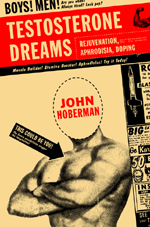DRCNet
Book
Review:
Sports,
Sex,
Eternal
Youth:
A
Cultural
History
of
Testosterone
3/25/05
"Testosterone Dreams: Rejuvenation, Aphrodisia, Doping," by John Hoberman, University of California Press, 2005, 381 pp., $24.95 PB Reviewed by Steve Beitler From the bedroom to the boardroom, from Olympic stadiums to the neighborhood YMCA, and in countless unseen pockets of everyday life, it is all about performance. Most of us have long since internalized the American creed of self-improvement; it's only natural to strive to do more and do it all better. In sports we want faster times and longer home runs from great athletes, who show that it is possible to transcend normality, mediocrity and perhaps the bounds of nature itself.
Testosterone was first synthesized in 1935, and it quickly began a career as a "charismatic" drug. "Pharmacological charisma means that public discussion of a drug takes for granted its power to significantly enhance the functioning of most people," Hoberman writes. He shows how testosterone has been "regarded as a rejuvenating drug, as a sexually stimulating drug, and as a doping drug that builds muscle and boosts athletic performance," and the book explores the history of each of these roles. Hoberman's purpose is to "illuminate the important and sometimes bizarre roles that testosterone drugs have assumed in clinical medicine and in the wider world of diverse personal needs and ambitions that range far beyond the therapeutic aims of the clinic." Hoberman focuses on the Olympics and elite cycling to show why performance-enhancing steroids are so prevalent and hard to root out. While the mainstream media relentlessly portray steroid use as individual deviance, Hoberman pierces this illusion in his discussion of the "mutual solidarity of the dopers and their medical counselors." Complicit as well are sports officials and federations. In the second half of the 20th century the International Olympic Committee (IOC) focused on building and then protecting the multi-billion dollar enterprise that the Olympics became. It ceded a lot of power to the federations that run different sports and to national Olympic committees, a decision that enabled the IOC to keep its distance from the realities of doping among Olympic athletes and to treat the issue primarily as a public relations matter. The federations and their athletes were interested in dramatic competition and breakthrough performances, while national Olympic committees (and many others) were under the sway of what the author calls sportive nationalism -- "the use of elite athletes by governments or other national bodies to demonstrate national fitness and vitality for the purpose of enhancing national prestige." The ultimate expression of sportive nationalism was the massive use of steroids and other performance-enhancing drugs in the 1970s and 1980s by East German athletes under the direction of their government. In the summer of 1998, many Americans were enthralled by a now-suspect drama that was unfolding in major league baseball. Mark McGwire and Sammy Sosa pursued the record for most home runs in a season, which both sluggers ended up surpassing. At the same time, the Tour de France, cycling's showcase event, was unraveling in what Hoberman calls the greatest doping scandal of the 20th century. It may well have been the greatest but it was far from the first in cycling. Hoberman says that "long-distance cycling was the most consistently drug-soaked sport of the twentieth century," and his retelling of that sport's story is an incisive look at how the quest for extreme performance has led to extreme self-medication. Hoberman ranges beyond the Olympics and cycling to link drugs in sports with broader patterns of drug use and the attempts to control both. "Athletic doping is comparable in important ways to the use of drugs in the larger society," he says, and he believes that "drug habits that do not appear to threaten the social and political equilibrium of a society will only be lightly regulated." For Hoberman the manic fury of the drug war is rooted in the belief that drug use is a dire challenge to the productivity and efficiency that are essential to America's prosperity and survival, with marijuana the signature threat to "the morale of a society that must produce and consume to survive." However, Hoberman notes that, given this emphasis on productivity, it is "only a deeply irrational view of drug abuse" that makes alcohol and nicotine acceptable while "recreational drugs that do far less damage to health and workplace productivity" are demonized. "Testosterone Dreams" is an ambitious and deeply informed analysis of issues that are growing in importance to the drug policy reform movement. The book ranges far beyond sound bites on steroids to shed light on little-known events and complex historical patterns. Hoberman's book asks a lot of the reader as it moves among the history of medicine, sports and the study of sex in America. Drug reformers and other readers will be richly rewarded with a fresh appreciation for connections and historical origins that today's headlines often obscure. In "Testosterone Dreams," John Hoberman gives a great performance.
|

